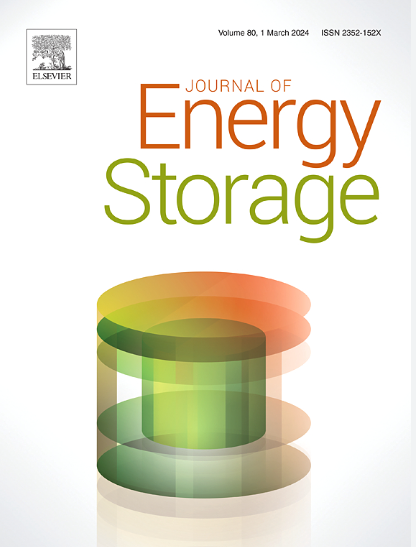Oxygen vacancy-engineered Nb2O5-x quantum dots confined in mesoporous CMK-3 host-guest architecture for synergistic dual-regulation of polysulfide redox kinetics in lithium‑sulfur batteries
IF 8.9
2区 工程技术
Q1 ENERGY & FUELS
引用次数: 0
Abstract
Defect engineering has emerged as a scalable strategy to address the lithium polysulfides (LiPSs) shuttling and sluggish reaction kinetics in lithium‑sulfur (Li![]() S) batteries. However, the relationship among defect structure, material architecture, and polysulfide redox kinetics remains insufficiently explored. Herein, Oxygen vacancy-engineered Nb2O5-x quantum dots confined within an ordered mesoporous tubular carbon (CMK-3) host-guest architecture, designed as Nb2O5-x@CMK-3, was successfully developed as a functional separator for Li
S) batteries. However, the relationship among defect structure, material architecture, and polysulfide redox kinetics remains insufficiently explored. Herein, Oxygen vacancy-engineered Nb2O5-x quantum dots confined within an ordered mesoporous tubular carbon (CMK-3) host-guest architecture, designed as Nb2O5-x@CMK-3, was successfully developed as a functional separator for Li![]() S batteries. The developed confinement strategy effectively suppresses the aggregation of Nb2O5-x quantum dots through spatial restriction within CMK-3 channels, and constructs a matrix integrating physical confinement with defect-mediated chemical interactions. This effectively regulates the deposition and conversion processes of sulfur, inhibits the shuttling of LiPSs, and promotes the kinetics of the sulfur electrode conversion reactions. Through the synergism of physical confinement, chemical adsorption, and catalytic conversion, the Li
S batteries. The developed confinement strategy effectively suppresses the aggregation of Nb2O5-x quantum dots through spatial restriction within CMK-3 channels, and constructs a matrix integrating physical confinement with defect-mediated chemical interactions. This effectively regulates the deposition and conversion processes of sulfur, inhibits the shuttling of LiPSs, and promotes the kinetics of the sulfur electrode conversion reactions. Through the synergism of physical confinement, chemical adsorption, and catalytic conversion, the Li![]() S batteries assembled with the Nb2O5-x@CMK-3 modified separators not only exhibit remarkable electrochemical performance but also achieve favorable stability under a high sulfur loading of 4.1 mg cm−2. This work has great potential in the development of multi-functional intermediate layers for high-performance Li
S batteries assembled with the Nb2O5-x@CMK-3 modified separators not only exhibit remarkable electrochemical performance but also achieve favorable stability under a high sulfur loading of 4.1 mg cm−2. This work has great potential in the development of multi-functional intermediate layers for high-performance Li![]() S batteries.
S batteries.

介孔CMK-3主客体结构中氧空位工程Nb2O5-x量子点对锂硫电池中多硫氧化还原动力学的协同双调控
缺陷工程已经成为解决锂硫电池中多硫化物锂(LiPSs)穿梭和反应动力学缓慢的可扩展策略。然而,缺陷结构、材料结构和多硫化物氧化还原动力学之间的关系仍未得到充分的探讨。本文中,氧空位工程的Nb2O5-x量子点被限制在有序介孔管状碳(CMK-3)主客体结构中,设计为Nb2O5-x@CMK-3,成功地开发了作为锂离子电池的功能隔膜。所开发的约束策略通过CMK-3通道内的空间限制有效抑制Nb2O5-x量子点的聚集,并构建了物理约束与缺陷介导的化学相互作用相结合的矩阵。这有效地调节了硫的沉积和转化过程,抑制了LiPSs的穿梭,促进了硫电极转化反应的动力学。通过物理约束、化学吸附和催化转化的协同作用,Nb2O5-x@CMK-3改性隔膜组装的锂离子电池不仅表现出优异的电化学性能,而且在4.1 mg cm−2的高硫负载下具有良好的稳定性。本研究对高性能锂离子电池多功能中间层的开发具有很大的潜力。
本文章由计算机程序翻译,如有差异,请以英文原文为准。
求助全文
约1分钟内获得全文
求助全文
来源期刊

Journal of energy storage
Energy-Renewable Energy, Sustainability and the Environment
CiteScore
11.80
自引率
24.50%
发文量
2262
审稿时长
69 days
期刊介绍:
Journal of energy storage focusses on all aspects of energy storage, in particular systems integration, electric grid integration, modelling and analysis, novel energy storage technologies, sizing and management strategies, business models for operation of storage systems and energy storage developments worldwide.
 求助内容:
求助内容: 应助结果提醒方式:
应助结果提醒方式:


